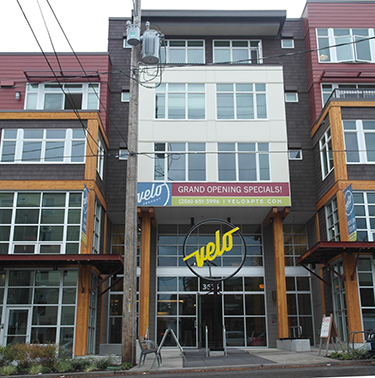|
Subscribe / Renew |
|
|
Contact Us |
|
| ► Subscribe to our Free Weekly Newsletter | |
| home | Welcome, sign in or click here to subscribe. | login |
Real Estate
| |
 |
December 11, 2014
Survey -- Mack Urban
Specialty: Long-term holdings, with investments in diverse asset classes including transit-orientated development, high-rise residential, mixed-use multifamily and adaptive reuse
Management: Paul Keller, founding principal and CEO
Founded: Los Angeles-based Urban Partners opened the Seattle office in 2005, acquired Harbor Properties in 2011 and merged as Mack Urban in 2013
Headquarters: Los Angeles, with an office in Seattle
Projects: 171-unit Velo apartments in Fremont; 137-unit Ray apartments on Stone Way North; 169-unit apartment building across Western Avenue from Harbor Steps
Paul Keller, founding principal and CEO of Mack Urban, discussed what his company invests in and how they are capitalizing on real estate trends in Seattle.
Q: What is your firm’s niche in real estate?
A: We have been focused on multifamily, mixed-use residential development. Moving forward, our focus will continue to include transit-orientated development, high-rise residential, mixed-use multifamily, adaptive reuse and possibly student and senior housing.
Q: Which regions have shown strong growth and why?
A: Our business model has two fundamental business types: development and value-add. We currently have 1.4 million gross square feet under construction, 2,500 residential units in development, over 475 units in lease-up and 12 stabilized assets in the portfolio.
All of these assets are located in the following West Coast gateway cities: Seattle, Portland and the greater Los Angeles/Orange County area. All share common attributes such as mass transit options, a vision for walkable neighborhoods, civic stakeholders who value the arts, recreation and culture, and municipalities that adopt smart growth policies in order to preserve open space.
Q: What trends are guiding your investment decisions?
A: We are pleased to see that employers are returning to city central business districts — and we believe that their capital investments are much more than a trend. When you have employers such as Amazon, Google and many others investing in urban campuses, it’s a net benefit for us all.
Q: How are you capitalizing on real estate trends in Seattle?
A: During the expansion of suburban sprawl, many of Seattle’s neighborhoods remained sleepy and underdeveloped with very little change. Today, we see urban in-fill in every neighborhood. Some of the new development is designed as an extension of the community, offering a sense of place, while other projects have an insular and more institutional design.
At Mack Urban, we believe that urban in-fill needs to do more than in-fill, it needs to “cultivate the in-between” — in other words, maintain and expand the connections between buildings, public spaces, local services, infrastructure and the community. We see the current multifamily trend as an opportunity to model projects designed to preserve neighborhood character and strengthen communities.
Q: What do you plan to do in the near future to capitalize on such trends?
A: We will let you know in 2015.
Other Stories:
- Relax; the lodging market looks strong
- Survey -- Daniels Real Estate
- Survey -- Harsch Investment Properties
- Survey -- Vulcan Real Estate
- Survey -- Capitol Hill Housing
- Survey -- Seco Development
- Sustainable workplace? Yes, but what about design?
- Don’t get rattled by earthquake insurance changes
- Become a big-shot developer with crowdfunding
- The ‘100 percent corner’ moves downtown
- Good news floods the South Sound market
- Here come more apartments; now what?
- Office market tightens as tech companies expand
- Survey -- Skanska USA Commercial Development



